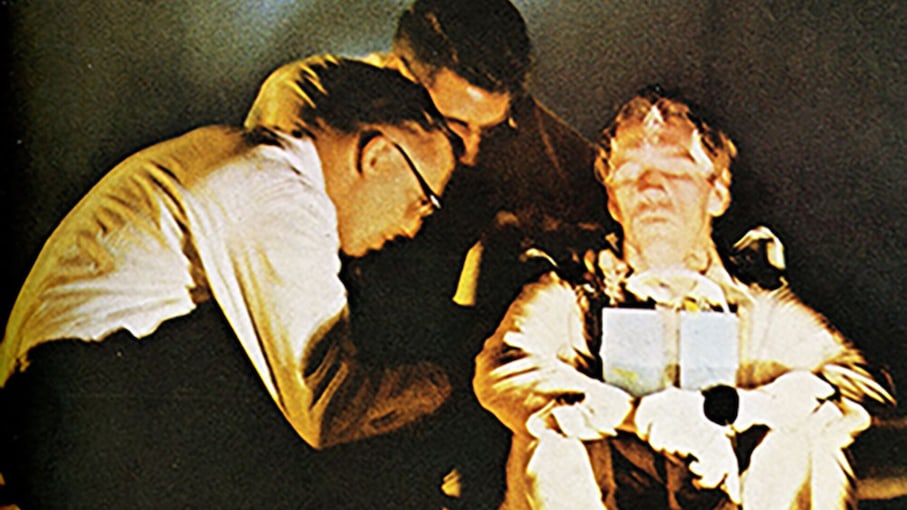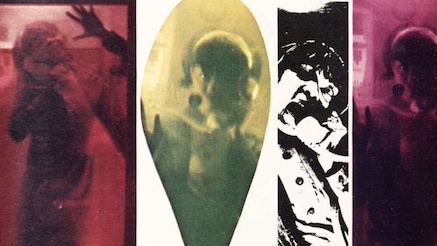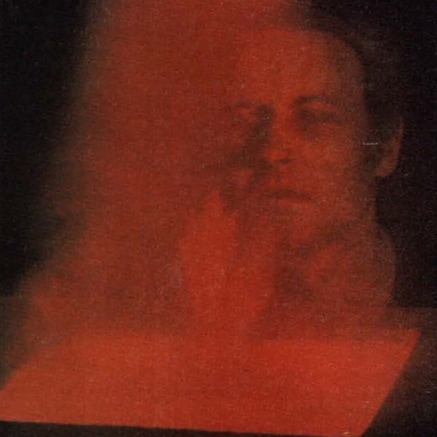The Experiments in Art and Technology (E.A.T) collective brought together Bell Labs engineers and New York City visual artists, choreographers and composers for 9 Evenings: Theatre and Engineering, a series of new art-performance works that changed music
9 Evenings is considered the first large-scale collaboration between artists and research engineers. The performances, which ran in October of 1966 featured many "firsts" for theatrical technology.
Innovations like television projections, fiber-optic cameras and doppler sonar devices were used onstage for the first time.
The shows, while controversial at the time, are now considered seminal pieces of modern art and a historical marker for the allegiance between artists and technologists.
Here, in rehearsals, two Bell Labs engineers check the equipment and make adjustments. In the piece, body sounds were amplified and transmitted to the audience.
Artists included John Cage, Lucinda Childs, Öyvind Fahlström, Alex Hay, Deborah Hay, Steve Paxton, Yvonne Rainer, Robert Rauschenberg, David Tudor and Robert Whitman, with many notable engineers involved including Bela Julesz, Billy Klüver, Max Mathews, John Pierce, Manfred Schroeder, and Fred Waldhauer. Recordings of the 9 Evenings performances have been curated by the Daniel Langlois Foundation for Art, Science, and Technology.
In a piece conceived by Argentine-born artist Marta Minujin and built by Bell Labs technical aide Per Biorn, a series of strange and unpredictable events occur when an audience member steps into a phone booth and picks up the receiver. Red and black liquid flows upward on the glass. Screens unfurl, sirens wail, colors flash.
The speaker's own voice talks back and their reaction is played back on a television set in the floor. All the effects were unwittingly controlled by the audience member. Not even the artist knew which effects would happen or even when they would be triggered.
9 Evenings was the brain child of Bell Labs engineer Billy Klüver and artist Robert Rauschenberg. Initially conceived as an event for the Stockholm Festival of Art and Technology, the plan fell through, but the idea for collaboration was sparked. More New York artists grew interested in participating.
Several Bell Labs engineers, mostly friends of Klüver's, volunteered their spare time and expertise. Klüver acted as a kind of coordinator, and for ten months, the two groups worked together to develop equipment, materials, and new devices that proved integral to the artists' performance concepts.
The following excerpt from a 1967 issue of Western Electric Magazine describes the first collaboration sessions with artists in preparation for the 9 Evenings event:
The early meetings between the two opposites lacked communication. The artists' ideas were vague and the engineers' explanations were too technical. It was frustrating. They searched for a common language.
At one of the evening meetings an engineer said, "Let's tell them some of the things they can use." So they did. Encoders, equalizers, systems that could control light and sound and objects. Decoders serving as small mobile computers which could be programmed.
The artists were enthusiastic. The possibilities! They were creating on the spot. Suggestions were made and counter suggestions offered. New ideas spring from their brainstorming sessions.
- Could I have wireless floating platforms?
- Is there a material that would stretch forever?
- I'd like to have seven movie projections on the ceiling, floor and walls at once.
- Is there a device I could use offstage to direct performers without being audible to the audience?
- Can you control an airborne object?
- Is it possible to wire a tennis racket to amplify the ball's sound as it makes contact?
In 9 Evenings, they accomplished nearly all these feats. In the following years, due in part to the success of the performances, the E.A.T. model spread. Regional E.A.T. chapters sprung up across the United States. Bell Labs engineers continued their participation in the program, and annual E.A.T. competitions were held, where artists and engineers were again paired up to see what they could create together.
Despite the enthusiasm for E.A.T.-style collaborations in the late 1960s and 1970s, the program went dormant in recent decades, perhaps because in many ways the ideas were so avant garde that they were well ahead of their time. That is, until Bell Labs brought E.A.T. back.
Outside of collaborations with artists, Bell Labs has a long and distinguished history in the creation and production of the digital arts. In video, Bell Labs broadcast the first long-distance TV signal in 1927, then transmitted the first satellite video signal across the Atlantic and pioneered HDTV technology.
In sound, Bell Labs invented high-fidelity stereo recording and reproduction in the early 1930s, and you have us to thank for synchronized-sound motion pictures (the talkies). We created the first computer-generated singing voice in 1961 and then pioneered the early fields of computer-generated graphics, art and movies.
Bell Labs also originated the basic signal-processing algorithms and hardware that are ubiquitous in music, video and other areas today.





